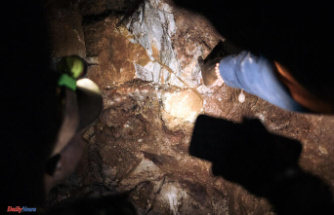"I felt bad, I dizzy and wanted to vomit. I did not know if it was because she had drunk too much or because she had been drugged, because she did not remember anything ». This is a testimony collected in one of the workshops organized by the Universitat de València to evaluate a Kit called Nosum that detects the GHB drug (gamma-hydroxybutyric acid) in the beverages, known as liquid ecstasy. The objective is none other than contributing to young people an instrument of personal protection capable of preventing sexual assault by chemical submission, which according to the Spanish Society of Emergency Medicine (SEMES) reach 20% of the total.
The allegations of victims of crimes that saw their willnum after consuming a drink have multiplied up to 500% and, in the case of sexual abuse, the profile is women under 30 who come to a hospital without reminding anything of what occurred and without trace of substances in your body. It is the case of the young man of Igualada, who comes to collation among the university students who come to this workshop in which the world also participates.
"Ecstasy is metabolized very fast: between six and 12 hours it disappears from the organism. That is why the important thing is to be able to prevent ». It counts Pablo Gaviña, a member of the Modelic Research Group that has developed the kit while distributing them between Thirty Students, as many girls as boys, who have come to be interested. Everyone is given an envelope with simple instructions, two small vials with the reagent, a droplet account, and are offered jars with beer, vodka with orange and a cola soda, some contaminated and others not.
What they have to do is take a drop of drink and introduce it into the vial, which by just shaking it will turn red indicating that there is GHB and, therefore, is contaminated. "The reliability of this test is very high and works," the researcher Silvia Rodríguez - both in pure alcoholic beverages and in combination and refreshments ". In addition, according to the latest advances, they have detected that the same vial can be used up to five times if there is not a positive.
The research group has been working for years in the detection of substances of biological interest and decided to undertake the way to make ecstasy detectable with simplicity, "for being the most common drug in chemical submissions," reflects Gaviña. In the discovery, already patented, there was some "serendipia", "because we were looking to synthesize another molecule, but we were wrong and we saw that this sensor worked better. We have up to three reagents that give different and even fluorescent colors ».
The efforts are now focused on polishing the kit, that is, doing it much more manageable - and it is- and discreet. "Because you have to beat what you are going to think about me if you see me doing the test," adds another of the researchers, Eating Venguut. They are in contact with the Technological Institute of Plastic (Aimplast) to make vials even smaller and have already seen a strip is much more practical, effective and discreet than the dropper. "It has to be something you can wear in your bag or in your pocket as a personal protective instrument," said Paul.
In fact, when it reaches the market it is so simple that its cost "could not exceed 50 cents and sell themselves as a parapharmacy product."
The problem is what to do after checking that someone has deposited drugs in the cup. The drink is discarded and flees from danger, but it can cost itself to identify who has done it and much more accuse you. «This test has no legal validity, although we are working on seeing what requirements would be needed so that it can be achieved," said Silvia before the questions of some young people, who proposed the possibility that these kit could be in the hands of toilets and forces of Security to corroborate the attempt of aggression. "At the moment, it serves to give tranquility, that it is not little watching the data and the figures at this time," Gaviña knocked. And not only before a possible criminal activity, but before the refusal to consume drugs in a recreational manner that, by the assessment generalized case in the room, it is deriving collective at university parties through drinks.
Essential part to progress this research, funded by the National Drug Plan and the Valencian Innovation Agency, is that the kit is used. In fact, it includes an envelope pranked so that students refer anonymously and free any positive sample they can find.
These workshops were coexisting for the students of the Valencian public universities, but, when it is a pioneering initiative aimed especially at young people, there are other centers that have already been directed to the team to disclose research. Specifically, there are scheduled online workshops with the universities of Zaragoza and Granada, which will be sent to you kits so that they distribute them among the participating students.
The imput that led this team of researchers to seek how to easily detect submission drugs on beverages was to see how girls were advised to come to premises to take the glasses to the bathroom so as not to lose sight of them. Even though there are cases at private parties or bottles, in pubs and discos is where they focus.
In fact, in the United Kingdom there has been a women's movement promoting boycott to certain premises after the proliferation of cases. The police have recognized that in the last two months there have been 198 confirmed cases of women who had drugs through their beverages. In the workshop debate organized by Nosum, these doubts also emerged: Can locations contribute to this surveillance?
The research group is contacting drink distribution companies, hospitality and nightlife associations to extend the project. "We think they could be in a local area, such as condoms' machines," Gaviña suggested. The widespread conclusion is that having this product, when it is marketed or experimentally within the investigation, could provide "a kind of quality seal" to the premises and dissuade from these practices.
While this does not happen and the kit is not standardized, the Council of the Chemicals is, before any symptom, supporting someone of trust to be accompanied and, in the case of having suspicions of an aggression, not washing, or changing clothes and Go as quickly as possible to a hospital to try to detect the presence in blood. The Community of Madrid is, for the time being, the only one that has a protocol before chemical submission in primary care centers.
Date Of Update: 08 November 2021, 11:24











